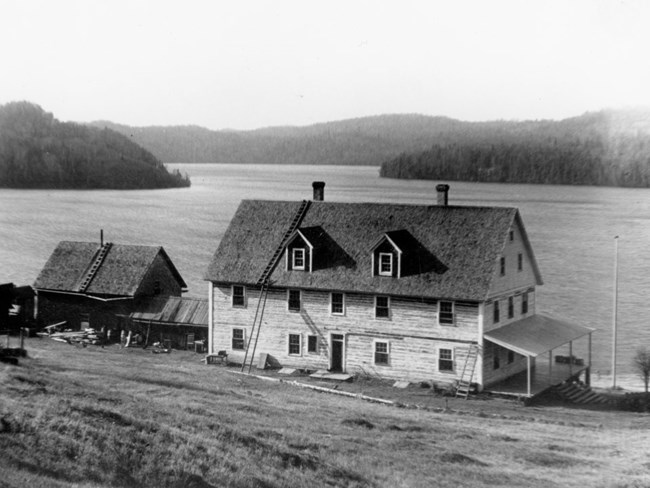Last updated: February 17, 2021
Article
Isle Royale Land Corporation

Fisher Collection
History
With the closing of Island Mine and Minong Mine, the island again remained uninhabited save for seasonal fishermen. The North American Mineral Land Company, aware that it had a bad investment on its hands, sought to dispose of its holdings and hired Jacob Houghton, the youngest brother of Douglass Houghton, to do the job. Jacob Houghton, who ran a shipping line from Hancock to Isle Royale, was an unrelenting optimist, whose faith in the potential for Isle Royale copper had lasted for forty years, never waning. This was a period in which the British were making large investments in American mines, and he finally succeeded in interesting a Liverpool syndicate in his copper dream. They took the name of the Isle Royale Land Corporation and purchased the holding of the North American Mineral Land Company as well as the Minong Interests (about 84,000 acres) for about three dollars an acre. While emphasizing the value of the copper, Houghton also stressed the land itself as an investment. He demonstrated his faith by buying 800 of the 10,000 shares.
Wendigo Copper Company
During the last years of mineral exploration on the island, the lsle Royale Land Corporation bought 84,000 acres of land at the western end of the island. Realizing their charter only gave them the right to search for minerals, not to mine them, they set up a subsidiary firm, the Wendigo Copper Company. In 1890, this new company was given 5,000 acres of land on the western end of Isle Royale. Their purpose was to search for and mine copper.
The base for the Wendigo Copper Company was the community of Ghyllbank, located at the head of Washington Harbor, which consisted of approximately 15 structures. The settlement consisted of sheds, storehouses, and double log cabins, each of which housed two families (Rakestraw n.d: 49). The structures provided housing for some of the miners and their families as well as the officers of the Wendigo Copper Company.
The most imposing structure was the company's 2½-story headquarters building. A dock facility was constructed to provide access and supplies to the western end of the island. A large area, approximately 1,300 ft by 700 ft was cleared of timber in order to construct the settlement as well as make room for a vegetable garden and a hay pasture (Rakestraw n.d.:49).
The Wendigo Copper Company explorations focused on diamond drilling of exploratory bore holes. Over a two-year period they bored 16 holes ranging in depth from 401 ft to 1,038 ft deep (USDI, NPS 1987). They were designed to give engineers a better look at a cross section of the island's geology. This information was used as a guide to possible copper locations in the area. Short exploratory trenches, or costeans, were also dug into the hillsides in search of copper deposits.
In addition to the community of Ghyllbank, a secondary settlement, Wendigo, was established about a mile and a half inland, closer to the mines. Wendigo consisted of two large boarding houses for the single men and a number of smaller log cabins for the married men and their families.
The mining community numbered about 135, of whom only sixty were men. There were at least twenty children of school age, and some pre-school children, including two infants born during the winter of 1890-91. The physician was both school teacher and customs officer. Tobogganing was a favorite sport during the winter with an excellent toboggan slide from the office building down the hill to the ice on the bay, and at night the slide was lit by lanterns. Mail service was regular, by way of Pigeon River carried by boats in summer and dog teams in winter, and there were few of the hardships that had marked the earlier settlements.
From 1890 to 1892 there was frenzied activity. Many miles of road were built in the Washington Harbor area and as far inland as Lake Desor. Much trenching was done to discover the nature of the bedrock in this area, as well as in Todd Harbor, and an extensive program of diamond drill exploration was carried out. (Incidentally, these rock cores give us our best knowledge of the geology of the island today.) But all this resulted in no production of copper. The rock was too poor to be mined profitably. In 1892 the activity ceased, the Wendigo company went out of existence, and the Isle Royale Land Corporation began selling its land for tourist homes and resorts.
